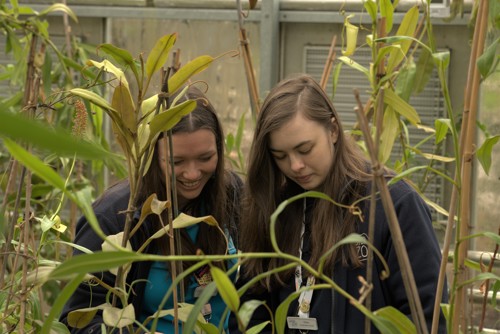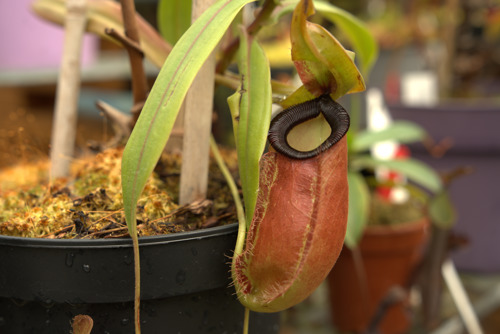
What corpse flowers can teach us about plant conservation
Members of the public are invited to discover Nepenthes pitcher plants, which survive by drowning and digesting insects.
A duo of corpse flower blooms have captured global attention. Now conservation scientists are calling for the horticultural community to learn from this to save other threatened plants.
Scientists at Chester Zoo say the attention and care given to the odorous titan arum plants currently blooming at the U.S. Botanic Garden and the University of Warsaw’s botanical gardens could be crucial for other species, including a family of ‘weird’ plants called Nepenthes.
Olivia Murrell, a Chester Zoo conservation scholar working on a study of Nepenthes, said: “I like weird plants. I think a lot of people find them interesting. Nepenthes are intriguing because they are carnivorous and they look very alien to us.”

What’s interesting is that Nepenthes are managed like most plants, but corpse flowers are treated more like an animal. They’re given names and people pay attention to their parentage. There is a definite bias in conservation toward charismatic species, and the corpse flower, because of its peculiarities, is a rare example of a charismatic plant. Other plants, like Nepenthes, could benefit from that kind of attention.
Olivia Murrell, Chester Zoo conservation scholar
Nepenthes are tropical pitcher plants. This family includes the largest carnivorous plant species in the world, the Nepenthes rajah, whose pitchers can grow 40cm high.
The pitchers that give them their name start as tendrils which gradually open at one end. The plant exudes a nectar, tempting insects to the rim of the pitcher where they fall in, drown and are slowly digested in enzyme-rich fluid.
Olivia said, “There are more than 180 species growing across wild habitats from Madagascar to the Pacific Islands, and many of them are endangered, while the data on others is lacking.”
The picture is similar in hothouses around the world. While animal sanctuaries, reserves and zoos use the Zoological Information Management System (ZIMS) to log and monitor the animals in their care and coordinate breeding programmes, plant data is less universally available. As a result, it is difficult for botanists to swap seeds and pollen as they might not be aware of what other institutions contain.
For some plant species that are extinct in the wild, which may include two species of Nepenthes, botanical gardens and collections offer a last chance of survival. A universally used database of cultivated plants could prove crucial to the eventual restoration of wild populations. The creation of plant studbooks would play a part in that.

Studbooks are used by the zoo community to track individual animals across different zoos and log important breeding data. Corpse flowers benefit from studbook data, which helps preserve their genetic diversity, but they are an exception among plants.
Olivia is hoping to help change that through her PhD at Manchester Metropolitan University and Chester Zoo. It focuses on Nepenthes and grows from her earlier studies focusing on corpse flowers.
Olivia said, “Often, at botanical gardens, only one corpse flower blooms at a time, and only for a few days every seven to 10 years. It’s a big occasion for the public and it’s also an opportunity for botanists to collect pollen to fertilise other plants. It’s like coordinating an animal breeding project.”
The titan arums flowering across the world are rare examples of plants that can draw crowds. Putricia, which opened at the Sydney Royal Botanic Gardens earlier this year, gathered thousands of devoted fans through a live webcam. Some gardens have had to limit tickets to control the number of visitors eager to experience the plant's characteristic odour of rotting meat.
In contrast, Olivia said, Nepenthes aren’t as well-known, even though they also have fascinating quirks. For instance, some species have evolved to encourage small mammals to use their pitchers as toilets, essentially a very direct way to gain fertiliser.
Olivia said of Nepenthes: "The data is very holey right now. It often doesn’t include a plant’s origin, its parents and detailed morphological information. I’m using the Chester Zoo collection to start filling in those blanks.”
Olivia is loading information into the Botanic Gardens Conservation International (BGCI) Plantsearch database. If she is successful in creating a databank for Nepenthes plants in collections, this could go a long way toward safeguarding endangered Nepenthes species and establishing a studbook. This would help organisations like Chester Zoo, which holds the Nepenthes National Plant Collection, to coordinate pollen-swapping, seed-swapping and plant relocations and re-introductions in the wild.
“It’s a lot of work for one person, so we’re happy to support this,” said Rebecca Lewis, Conservation Scientist in Population Biology at Chester Zoo, who helps Olivia log aspects of the zoo’s Nepenthes collection, and offers guidance based on her experience working with animal data.
Having the National Collection of Nepenthes allows us to implement work like Olivia’s project. Because we have the largest collection in the UK, we have a great starting point for inputting population information and implementing a studbook. When big organisations start adopting a new practice, this tends to leak across to hobbyists and private collectors, so it could have benefits across the whole field of horticulture.
Rebecca Lewis, Chester Zoo Conservation Scientist in Population Biology